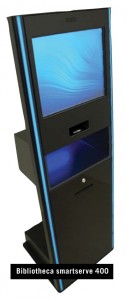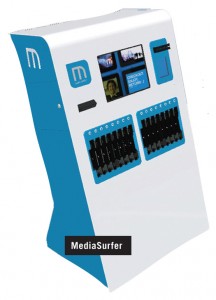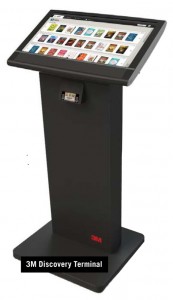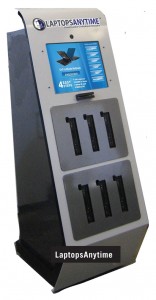New self-service technologies help users find ebooks, check out laptops, and even pay their water bill
With many libraries facing the squeeze of rising usage and flat or declining funding, self-service technologies have become more of a necessity. Librarians who discussed these technologies with LJ said that self-service options generally improve service overall. With these tools in place, staff have more time to answer questions and assist patrons.
Self-service technologies may also help raise the visibility of certain services or portions of a collection. Take ebooks, for example. In April, the Pew Research Center’s Internet and American Life Project released a study indicating that 43 percent of American adults have read a book or other long-form content on an ereader. In a separate study released in June, only 22 percent of respondents said that they knew that they could borrow ebooks from their library, while 14 percent were convinced that they couldn’t.
With the popularity of ebooks growing, this lack of awareness is certainly disappointing. Yet new kiosks, such as 3M’s Cloud Library Discovery Terminals, and discovery centers such as the new Media Stations that OverDrive is testing for touchscreen monitors and Internet workstations promise to raise the profile of ebooks and simplify downloading within the library.
On the Ebook Track
A few months after the Contra Costa County Library (CCCL) debuted its three Library-a-Go-Go book vending units in 2008 and 2009, LJ wrote that the machines had “proved a tremendous aid in addressing underserved segments of this sprawling community” near Berkeley, CA. During its first year of operation, the unit at a busy Bay Area Rapid Transit (BART) station was circulating an average of 135 books per month from its collection of 400 titles. In a survey conducted by the library, 84 percent of respondents rated the service as “excellent,” while 73 percent said that they already considered the machines their main library branch.
Yet usage has since dropped sharply. According to a report in the El Cerrito Patch, the machine at the El Cerrito del Norte BART station—previously the highest-volume unit—was on track to lend about 235 books during the entire fiscal year of 2012.
The growing popularity of ebooks could be responsible for this sudden decline, although Cathy Sanford, deputy librarian for CCCL, also says that budget cuts have curtailed the occasional in-person demos to help new users. “We saw a huge difference [in circulation] the year that we stopped doing that,” Sanford says.
Sanford is hoping that occasional in-person marketing efforts will help boost usage. But she said that a lot of commuters do appear to be transitioning to ereaders.
“When I get on BART, I see people reading—on their phones, on a handheld device, on their tablets,” she says. CCCL responded to that trend with its “Snap & Go” marketing campaign, which uses QR codes on posters at BART stations and trains to direct commuters to the library’s mobile website, where they can download ebooks or audiobooks. The campaign led to a 16 percent sustained increase in mobile site traffic and won a 2012 John Cotton Dana Award.
“It’s really an opportunity for people to browse, sample, and read,” OverDrive president and CEO Steve Potash explained during a meeting with LJ this summer.
Potash previewed a video showing the Media Stations in a pilot test at a new branch of Cuyahoga County Public Library, Parma, OH. Patrons interacted with two prominent touchscreen monitors, browsing the library’s selection of ebook content and reading books that loaded quickly via “OverDrive Read,” the company’s new browser-based ebook platform.
St. Paul Public Library (SPPL) was a beta tester of the new 3M Cloud Library and its Discovery Terminals. And while SPPL director Kit Hadley notes that libraries still need to raise awareness of ebook collections among the general public, she says the kiosks did help make ebooks more visible for existing users.
“This is part of 3M’s philosophy that I really appreciate, which is to try to integrate the digital into the physical [collection],” she says.
The Discovery Terminals include an intuitive “shelf”-based ebook browsing experience, and downloading is simple. When selecting a title, users don’t have to navigate away from the 3M interface. Since content is stored on a cloud server, it can be read and synced on up to six devices, including PCs, Macs, iPads, NOOKs, iPhones, Android devices, and new 3M ereaders specifically designed for lending environments.
3M has also made an effort to simplify sign-up for the service. Users download the 3M cloud app to their device, select their participating library, and then put in their library ID. Once these steps are completed and a cloud account is established, patrons can simply scan their library card’s barcode at the Discovery Terminal kiosk, choose an available title, and the book will be automatically uploaded to that cloud account and readable on their device, as Matt Tempelis, 3M Cloud Library global business manager, demonstrated for LJ at the American Library Association’s annual conference held in Anaheim, CA, in June.
Community hub
Other companies are using new software to extend the concept of self-service beyond the library’s walls.
When One Equity Partners, a division of JPMorgan Chase, acquired and merged with Swiss-based Bibliotheca, U.S.-based Integrated Technology Group (ITG), and UK-based Intellident last year, the company benefited not only by expanding its global reach but also by bringing together teams of people working to solve different types of challenges facing libraries and library users worldwide.
One exciting new project is the company’s myCommunity initiative. Currently in pilot-test stage in the UK, this library-focused initiative is integrated into Bibliotheca’s recently launched smartserve 400 kiosk range. It enables users who are less confident with computers and online payment systems with the opportunity to use simple touchscreen interfaces—such as the PC booking and print management tools available through Bibliotheca’s A.L.P.S. application—to interact with local government agencies. With myCommunity, a smartserve 400 kiosk can be set up to allow patrons to buy a bus pass, register to vote, schedule a tee time at a local public golf course, or pay local taxes, bills, and traffic tickets.

“The Bibliotheca self-service kiosks offer the opportunity to meet the needs of those users who require a ‘click and go’ experience, to make a routine card payment without needing to wait for long periods for the machine to be available,” Bibliotheca marketing specialist Meghan Davis says. “The application provides fast access to those who don’t have regular web connectivity, the capability to set up a direct debit, or the mobility to get to payment offices.”
The benefits for libraries are twofold. First, the kiosks could potentially draw more foot traffic, allowing libraries to promote other services to a new set of patrons. As Davis explains, the myCommunity initiative “is about enabling the library to become the focal point of the community it sits in” and offer services beyond circulating materials and offering access to computers. Also, since the library would be facilitating and simplifying these transactions, libraries could potentially negotiate a fee with those agencies or businesses.
“Once you have a cash box attached to the kiosk, that opens up another world of possibilities,” says Al Coalla, director of sales for Bibliotheca. “If you have a way to collect money, whether it’s coins or notes or a credit card, why not leverage the cash collection aspect for other noncirculation-related activities?”
Dispensing knowledge
Obtaining ereaders and tablet computers can be a self-service transaction as well. For example, Tech Logic, which has its roots in automated materials handling and RFID checkin and checkout systems, recently introduced MediaSurfer. The stand-alone kiosk securely locks away iPads and then dispenses them when patrons swipe a valid credit card and a library card, which the system automatically compares with the library’s user database to ensure that the patron is in good standing and authorized to check these items out. Future units will dispense other types of tablets as well.
Tech Logic president Gary Kirk explains that the company’s background in self-service technologies for libraries had served them well when designing MediaSurfer’s user interface. Checkout is designed to involve as few steps as possible for the user, while maintaining security of these high-value items for the library.

“The system communicates with the ILS, so we know the right pieces of information are getting sent back and forth to authenticate [the user],” Kirk says. “All of that happens instantly in the background, which makes it very easy for the patron.”
“We see huge potential for more self-service tools in libraries, including kiosks and other types of technologies,” says Kirk.
Clara Di Felice, director of California’s Beaumont Library District (BLD), says she found the concept of self-service tablet checkout interesting, since tablets work well for many popular PC functions, and offering tablets while perhaps cutting a couple of PC workstations could be another way to free up space in the heavily used, 10,000 square foot library.
Silicon Valley–based LaptopsAnytime has been developing self-service laptop and tablet checkout kiosks since 2008 and is currently working with major library systems including County of Los Angeles Public Library, North Carolina State University Libraries, and Westminster College Libraries, Salt Lake City.

Cofounder Jonathan Ruttenberg says that the kiosks offer other benefits in addition to space savings. Universities, for example, can allow these systems to run 24-7. The LaptopsAnytime kiosks are also set up to communicate not only with users about the status of a device—whether a laptop or tablet is fully charged, for example—but also with staff, notifying them when an individual device needs to be serviced.
The LaptopsAnytime systems are also “device agnostic,” Ruttenberg says. “We can mix and match any number of device models (from Dell, Apple, HP, Acer, Lenovo, Toshiba, Amazon Kindle, iPads, etc.), whether [they are] laptops, netbooks, tablets or ebook readers within the same system.”
Checking in
The potential efficiencies that these newer self-service stations would introduce might be best illustrated by existing technologies, like self-checkin kiosks.
For example, in 2008, a sudden spike in the local population led to a significant, ongoing increase in the circulation of California’s BLD—from about 400 items per day to about 1000.
“We’re a small town in southern California…and we went from district population of 25,000 people to about 70,000 people in the space of about three years,” says director Di Felice. After the housing boom fueled a temporary increase in funding, Di Felice invested in self-service technology, realizing that the library would likely stay just as busy, even if funding later leveled off, which it did.
The library is now 100 percent self-checkin, and Di Felice says that it has enabled BLD to become more customer service focused. Staff who once sat behind a circulation desk now walk the floor as “Information Concierges,” helping patrons with directions around the library, sending them to a librarian for more specialized questions, or simply showing them how to use any automated equipment.

Similarly, Hadley in St. Paul says that the new 3M SelfCheck systems that SPPL began rolling out last year have helped solve two problems. First, many patrons like to get a receipt to prove that they returned a book. By dispensing receipts on request, these units help cut down on disputes or complaints about returns.
Second, the systems check in items immediately, clearing a patron’s record and allowing checkout of other items that may be restricted by a checkout limit.
“We’ve got this limit on the number of CDs and DVDs” that a patron can have checked out simultaneously, Hadley explains. “You can only have six out at one time. So we get people who bring their six in, and they want you to check them in immediately so they can check six more out. This automatically clears the record without staff intervention.”
The systems have also sped up workflow, freed up staff time, and prevented repetitive stress injuries, Hadley says, but she describes the rationale for installing the systems as “unconnected to budget concerns.”
“If our budget were increasing, we would want to do this, because we want to have staff focus more on people and less on things…. With our budget decreasing, the same is true,” she says.


